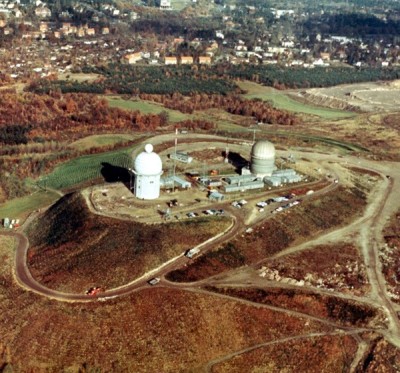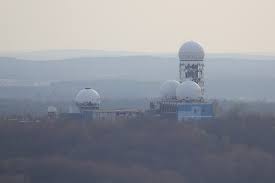From the end
of World War II in 1946 until the implosion of the Soviet bloc in 1989, the
divided German city of Berlin was a surreal study in contrast, between the
grim austerity of communist oppression in the east, and the gaudy show of
democratic capitalism in the west. But beneath the daily routine and surface posturing,
there was also a seething underlayer of tense military confrontation, blockades and
airlifts, wall-building and tunnel-digging, international plots and intrigues,
prisoner-swaps and espionage. Situated as it was 175 km. behind the Iron
Curtain, the former German capital was renowned among
Cold War intelligence and counter-intelligence forces as "the spy capital of
the world."
Integral to this scenario were several installations built
by the occupying powers—Soviet, French, British, and American—for the purpose
of learning what their adversaries were up to, both politically and
militarily. There were four such American installations: Andrews
Barracks in Lichterfelde (HQ & support); Grunewald (operations); Rudow
(operations); and Teufelsberg (operations).
This was the
world in which I performed my overseas military service, from late 1965 until early
1969. The operations site to which I was assigned was located in the
British Sector of West Berlin, on the edge of Grunewald forest.
It was perched atop
a man-made hill, officially named Teufelsberg (Devil's Mountain), and
known unofficially as "Spook Hill." The hill itself was built of 12
million cubic meters of World War II rubble trucked in from the western
sectors of the city over two decades, and British and American security forces found its summit—towering 90 meters
above the surrounding river plain—an opportune spot for an
intelligence-gathering operation. The photo
below shows the site as it appeared in the 1960s during my assignment.
Teufelsberg: late 1960s

Photo by Andy Fraser, courtesy USASA FSB Reunion
For most of my
38-month tour of duty in West Berlin, my workplace was
in the cylindrical structure supporting the single geodesic radome on the left
in the photo above.
The larger ground structure with the triple-deck inflated dome on the right was
where the bulk of the site's day-to-day work actually occurred, whereas my unit
functioned in a research-and-development capacity. Both were 24/7
operations, running three rotating shifts, plus a permanent day crew five days a
week. Even now, half a century later, I'm not at liberty to divulge
exactly what went on there. However, you're free to examine the
declassified aerial photos, consider the circumstances of the time (Cold War,
Vietnam conflict, Czech uprising, Israel repelling an attack by its Arab
neighbors) and the meaning of our motto, Semper Vigilis (Ever Vigilant), and speculate to your heart's and your imagination's content.
Ever since its
humble origin as a slap-dash mobile unit in 1951, the Teufelsberg installation
has been evolving. By 1975, the single-story structure to the right,
supporting the inflatable radome, had been replaced by a permanent two-story
structure topped by three rigid geodesic domes. In addition, the British
M.I. unit had installed a 100-meter high antenna tower (removed when the site
was abandoned).
Soon after the
fall of the Berlin Wall, speculation arose that this site would eventually
be decommissioned, and perhaps converted to a restaurant to
complement the modest public ski run that had already been built on the northern
slope—or perhaps a Cold War museum. However, such hopes were never realized.
Intelligence personnel were indeed withdrawn from this and other sites in 1991,
but plans to repurpose the facilities never materialized.
Teufelsberg: 2000s

Photo: Wikipedia
Gutted of the
tons of equipment they once contained, the remaining ghostly structural shells are
derelict and weather-beaten. There they stand, slowly rusting, rotting, and crumbling away, eventually to become one with the toxic ground that supports
them. (Come to think of it, that might describe many of us who used
to work there!) Nowadays, the site is visited routinely only by wild
boar and rabbits, and occasionally by vandals.
=SAJ=
OTHER WEBSITES
DEDICATED TO THE ASA, INSCOM, NSA, AND OTHER U.S. INTELLIGENCE UNITS IN BERLIN



